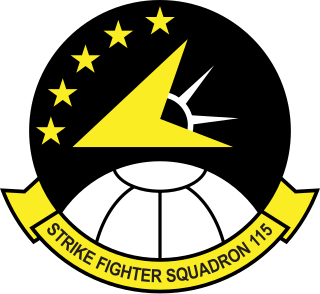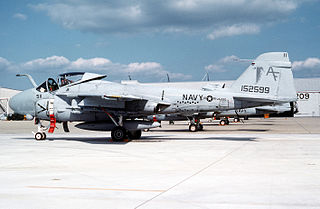
The Grumman A-6 Intruder is an American twinjet all-weather attack aircraft developed and manufactured by American aircraft company Grumman Aerospace and formerly operated by the U.S. Navy and U.S. Marine Corps.

USS Joseph Strauss (DDG-16), named for Admiral Joseph Strauss USN (1861–1948), was a Charles F. Adams-class guided missile destroyer of the United States Navy.

Operation Praying Mantis was the 18 April 1988 attack by the United States on Iranian naval targets in the Persian Gulf in retaliation for the mining of a U.S. warship four days earlier.

Strike Fighter Squadron 115 (VFA-115) is known as the "Eagles", callsign "Talon", a United States Navy F/A-18E Super Hornet strike fighter squadron stationed at Marine Corps Air Station Iwakuni. Their tail code is NF. It was established as Torpedo Squadron VT-11 on 10 October 1942, redesignated VA-12A on 15 November 1946, VA-115 on 15 July 1948, then finally VFA-115.

Attack Squadron 65 (VA-65), nicknamed The World Famous Fighting Tigers, was an attack squadron of the United States Navy. The squadron was established as Torpedo Squadron VT-74 in 1945, redesignated as VA-2B in 1946, as VA-25 on 1 September 1948, and finally redesignated VA-65 on 1 July 1959. It was disestablished in 1993. Known as "The World Famous Fighting Tigers", VA-65 was one of the last medium attack squadrons to fly the A-6 Intruder and the A-1 Skyraider. It was the second squadron to be designated VA-65, the first VA-65 was redesignated from VA-6B on 27 July 1948 and would be redesignated as VA-25 on 1 July 1959.

Strike Fighter Squadron 34 (VFA-34), also known as the "Blue Blasters", is a United States Navy F/A-18E Super Hornet strike fighter squadron stationed at Naval Air Station Oceana. They are a part of Carrier Air Wing 11 and are attached to the aircraft carrier USS Theodore Roosevelt. Their tail code is NH and their radio call sign is "Joker".

Iranian frigate Sahand was a British-made Vosper Mark V class frigate commissioned as part of a four-ship order. She was launched in 1969. The ship was originally called Faramarz, named after a character in Ferdowsi's Shahnameh. After the 1979 Islamic Revolution it was renamed Sahand, after the Sahand volcano.

Carrier Air Wing Eleven (CVW-11) is a United States Navy aircraft carrier air wing based at Naval Air Station Lemoore, California. The air wing is attached to the aircraft carrier USS Theodore Roosevelt.

In the Action in the Gulf of Sidra, codenamed Operation Prairie Fire, the United States Navy deployed aircraft carrier groups in the disputed Gulf of Sidra in the Mediterranean Sea. Libya had claimed that the entire Gulf was their territory, at 32° 30' N, with an exclusive 62 nautical miles fishing zone. Libyan leader Muammar Gaddafi asserted this in 1973, and dubbed it "The Line of Death". The United States claimed its rights to conduct naval operations in international waters, a standard of 12-nautical-mile territorial limit from a country's shore. This engagement followed the 1981 Gulf of Sidra incident and preceded another in 1989.

Attack Squadron 75 (VA-75) or ATKRON 75 was an attack squadron of the United States Navy that was active from World War II through the 1990s. Nicknamed the "Sunday Punchers," they were based out of Naval Air Station Oceana, Virginia. Originally established as Bombing Squadron EIGHTEEN (VB-18) on 20 July 1943, it was redesignated Attack Squadron VA-7A on 15 November 1946, redesignated Attack Squadron VA-74 on 27 July 1948, redesignated Attack Squadron VA-75 on 15 February 1950 and disestablished on 28 February 1997. They were the second squadron to be designated VA-75, the first VA-75 was disestablished on 30 November 1949. They were the first fleet squadron to operate the A-6 Intruder and the last unit to fly it in operational service.

VA-52 was an Attack Squadron of the U.S. Navy. It was established as U.S. Navy Reserve Fighter Squadron VF-884 on 1 November 1949, and called to active duty on 20 July 1950. It was redesignated VF-144 on 4 February 1953, and VA-52 on 23 February 1959. The squadron was nicknamed the Bitter Birds from about 1951–1953, and the Knightriders from about 1960 onward. Its insignia evolved through several versions and variations from 1951 to the 1980s. VA-52 was decommissioned on 31 March 1995.

VA-55, nicknamed the Warhorses, was an Attack Squadron of the U.S. Navy. The squadron was established at NAS Oceana, Virginia, on 7 October 1983, and flew the A-6E and KA-6D variants of the Grumman A-6 Intruder. It was disestablished on 1 January 1991, having been based at NAS Oceana during its entire lifetime. It was the second squadron to be designated VA-55, the first VA-55 was disestablished on 12 December 1975.

Attack Squadron 85 or VA-85 was a long-lived Attack Squadron of the U.S. Navy. It was called to active duty as U.S. Navy Reserve squadron VA-859 on 1 February 1951 and redesignated VA-85 on 4 February 1953. It was disestablished on 30 September 1994, over 40 years later. The squadron's nickname from 1958-1994 was the Black Falcons. It was the second squadron to be designated VA-85, the first VA-85 was disestablished on 29 November 1949.

Attack Squadron 145 (VA-145) was an aviation unit of the United States Navy, nicknamed the Rustlers from 1951-1954, and the Swordsmen thereafter. The squadron was established as Reserve squadron VA-702 on 1 December 1949, and called to active duty on 20 July 1950. It was redesignated VA-145 on 4 February 1953, and disestablished on 1 October 1993.

Attack Squadron 155 or VA-155 was an Attack Squadron of the U.S. Navy. It was established on 1 September 1987 and disestablished on 30 April 1993. It was the third squadron to be named VA-155, the first VA-155 was disestablished on 30 November 1949 and second VA-155 was originally established in 1946, redesignated as VA-155 on 4 February 1953, and disestablished on 30 September 1977. Its nickname, shared with the second VA-155 was the Silver Foxes.

VA-165, nicknamed the Boomers, was a long-lived Attack Squadron of the U.S. Navy. It was established on 1 September 1960, and disestablished 35 years later on 30 September 1996. The squadron operated in the region of Vietnam, Laos, and Korea during the 1960s and early 1970s. VA-165 transferred to the Persian Gulf after the 1973 Yom Kippur War, and also served near the Philippines during the late 1970s. During the 1980s, VA-165 was moved from the Middle East to Central America, particularly Nicaragua, back to Iran in the Middle East, off to South Korea, and then to the Middle East again for Kuwait. During the 1990s, the squadron worked in the United States, the Middle East, and Taiwan.

Attack Squadron 196 (VA-196) was an aviation unit of the United States Navy. It was established as Fighter Squadron 153 (VF-153) on 15 July 1948, redesignated as VF-194 on 15 February 1950, and finally redesignated VA-196 on 4 May 1955. Its nicknames were the Thundercats from 1948 to the 1950s, and The Main Battery from the 1950s thereafter. Beginning in 1979 the squadron used the nickname Milestones interchangeably with Main Battery. The squadron was disestablished on 21 March 1997, after more than 48 years of service.

VA-205, nicknamed the Green Falcons, was an Attack Squadron of the U.S. Naval Reserve, based at Naval Air Station Atlanta, Georgia. It was established on 1 July 1970 and disestablished on 31 December 1994.

Dee Leon Mewbourne is a retired United States Navy vice admiral who served as 16th deputy commander of United States Transportation Command between July 2, 2019 and June 29, 2022.
In 1989, the United States Navy was on the verge of massive cuts to military spending cuts including ship and aircraft procurement. These forces were expected to fight the Soviet Union, Warsaw Pact and other potential adversaries in case of a war breaking out. At this time, the USS Kitty Hawk (CV-63) of the Pacific Fleet was out of commission for Service Life Extension Program (SLEP) modernization leaving the 3rd Fleet with less carriers.






















